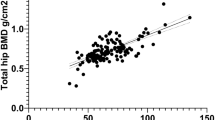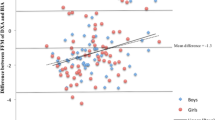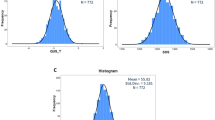Abstract
Background:
Quantitative ultrasound (QUS) is a quick, non-invasive and inexpensive method to measure bone strength. Moreover, the device is portable, which makes it easy to be used in the field. In contrast to other bone measuring techniques, QUS does not use any ionised radiation. However, the validity of QUS in the measurement of bone health and the relationship between QUS output and body composition have not been assessed in very young children.
Objective:
To investigate the relationship between paediatric calcaneal QUS and both dual-energy X-ray absorptiometry (DXA) and calcaneal DXA with laser (DXL) and body composition parameters.
Subjects:
A total of 37 Belgian children (10 boys and 27 girls; 4 to 8 years old) underwent a calcaneal QUS as well as a DXA scan. A total of 24 Swedish children (15 boys and 9 girls; 3 to 5 years old) underwent a calcaneal QUS as well as a heel DXL scan. The height and weight of all children were measured.
Results:
The QUS stiffness index (SI) was significantly negatively correlated with bone mineral density (BMD) of the total body (r=−0.370, P=0.02). No significant correlations were found between the SI and DXL results. In the total sample, the SI showed a significant positive correlation with body mass index (BMI) (r=0.298, P=0.02), even after correction for age, gender and centre. In the Belgian sample, the SI was also significantly positively correlated with total body fat mass content (r=0.416, P=0.01) and body fat percentage (r=0.566, P<0.01) obtained by whole-body DXA.
Conclusion:
The SI measured by QUS does not correlate significantly with BMD values measured by DXA or DXL in 3- to 8-year-old children. However, there is a significant positive correlation between SI and BMI and body fat %.
This is a preview of subscription content, access via your institution
Access options
Subscribe to this journal
Receive 12 print issues and online access
$259.00 per year
only $21.58 per issue
Buy this article
- Purchase on Springer Link
- Instant access to full article PDF
Prices may be subject to local taxes which are calculated during checkout
Similar content being viewed by others
References
Lanham-New SA . Importance of calcium, vitamin D and vitamin K for osteoporosis prevention and treatment. Proc Nutr Soc 2008; 67: 163–176.
Bonura F . Prevention, screening, and management of osteoporosis: an overview of the current strategies. Postgrad Med 2009; 121: 5–17.
Binkley TL, Berry R, Specker BL . Methods for measurement of pediatric bone. Rev Endocr Metab Disord 2008; 9: 95–106.
Baroncelli GI . Quantitative ultrasound methods to assess bone mineral status in children: technical characteristics, performance, and clinical application. Pediatr Res 2008; 63: 220–228.
Soderpalm AC, Kullenberg R, Wikland KA, Swolin-Eide D . Pediatric reference data for bone mineral density in the calcaneus for healthy children 2, 4, and 7 years of age by dual-energy X-ray absorptiometry and laser. J Clin Densitom 2005; 8: 305–313.
Brukx LJCE, Waelkens JJJ . Evaluation of the usefulness of a quantitative ultrasound device in screening of bone mineral density in children. Ann Hum Biol 2003; 30: 304–315.
Jaworski M, Lebiedowski M, Lorenc RS, Trempe J . Ultrasound bone-measurement in pediatric subjects. Calcif Tissue Int 1995; 56: 368–371.
Economos CD, Sacheck JM, Wacker W, Shea K, Naumova EN . Precision of Lunar Achilles plus bone quality measurements: time dependency and multiple machine use in field studies. Br J Radiol 2007; 80: 919–925.
Ahrens W, Bammann K, de Henauw S, Halford J, Palou A, Pigeot I et al. Understanding and preventing childhood obesity and related disorders—IDEFICS: A European multilevel epidemiological approach. Nutr Metab Cardiovasc Dis 2006; 16: 302–308.
Mughal MZ, Langton CM, Utretch G, Morrison J, Specker BL . Comparison between broadband ultrasound attenuation of the calcaneum and total body bone mineral density in children. Acta Paediatr 1996; 85: 663–665.
Wang QJ, Nicholson PHF, Timonen J, Alen M, Moilanen P, Suominen H et al. Monitoring bone growth using quantitative ultrasound in comparison with DXA and pQCT. J Clin Densitom 2008; 11: 295–301.
Sundberg M, Gardsell P, Johnell O, Ornstein E, Sernbo I . Comparison of quantitative ultrasound measurements in calcaneus with DXA and SXA at other skeletal sites: a population-based study on 280 children aged 11–16 years. Osteoporos Int 1998; 8: 410–417.
Lum CK, Wang MC, Moore E, Wilson DM, Marcus R, Bachrach LK . A comparison of calcaneus ultrasound and dual X-ray absorptiometry in healthy North American youths and young adults. J Clin Densitom 1999; 2: 403–411.
Cole TJ, Freeman JV, Preece MA . British 1990 growth reference centiles for weight, height, body mass index and head circumference fitted by maximum penalized likelihood. Stat Med 1998; 17: 407–429.
Christel P, Cerf G, Pilla AA . Evolution of the Mechanical-Properties of Callus Tissues on Rats. J Biophys Med Nucl 1981; 5: 21–26.
Bammann K, Sioen I, Huybrechts I, Casajús JA, Vicente-Rodríguez G, Cuthill R et al. The IDEFICS validation study on field methods for assessing physical activity and body composition in children: design and data collection. Int J Obes 2011; 35 (Suppl 1): S79–S87.
Soderpalm AC, Magnusson P, Ahlander AC, Karlsson J, Kroksmark AK, Tulinius M et al. Low bone mineral density and decreased bone turnover in Duchenne muscular dystrophy. Neuromuscul Disord 2007; 17: 919–928.
Mughal MZ, Ward K, Qayyum N, Langton CM . Assessment of bone status using the contact ultrasound bone analyser. Arch Dis Child 1997; 76: 535–536.
Acknowledgements
This study was conducted as part of the IDEFICS study (http://www.idefics.eu). We gratefully acknowledge the financial support of the European Community within the Sixth RTD Framework Programme Contract No. 016181 (FOOD). We thank all participants for their contribution. We acknowledge Anne Dohsé for the DXL measurements. TDV received two Research Flanders. GS received consulting funds from Eli Lilly and Company, lecture funds from MSD, F Hoffmann-La Roche Ltd, Warner Chillcott, Servier, and grant support from MSD, F Hoffmann-La Roche Ltd and Warner Chillcott, Servier. The information in this document reflects the author's view and is provided as is.
Author information
Authors and Affiliations
Consortia
Corresponding author
Ethics declarations
Competing interests
The authors declare no conflict of interest.
Rights and permissions
About this article
Cite this article
Sioen, I., Goemare, S., Ahrens, W. et al. The relationship between paediatric calcaneal quantitative ultrasound measurements and dual energy X-ray absorptiometry (DXA) and DXA with laser (DXL) as well as body composition. Int J Obes 35 (Suppl 1), S125–S130 (2011). https://doi.org/10.1038/ijo.2011.44
Published:
Issue Date:
DOI: https://doi.org/10.1038/ijo.2011.44
Keywords
This article is cited by
-
Validity of quantitative ultrasound and bioelectrical impedance analysis for measuring bone density and body composition in children
European Journal of Clinical Nutrition (2021)
-
Impact of physical activity, sedentary behaviour and muscle strength on bone stiffness in 2–10-year-old children-cross-sectional results from the IDEFICS study
International Journal of Behavioral Nutrition and Physical Activity (2015)
-
Five-minutes-to-twelve for implementation of early changes in dietary and lifestyle behaviour across Europe
International Journal of Obesity (2011)
-
The IDEFICS cohort: design, characteristics and participation in the baseline survey
International Journal of Obesity (2011)



